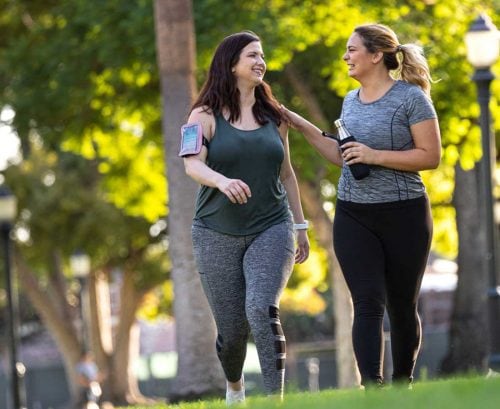
It’s easy to step up your everyday stroll to turn it into an effective workout – step this way and we’ll show you how walk your way to wellbeing.
Walking is the easiest form of exercise for us all to take up – just step up your leisurely stroll through the park or daily walk to the bus stop and you’ll soon see your stamina, health and general wellbeing start to improve.
It’s a simple change many of us could benefit from. According to a UK report it’s not uncommon for many of us to spend up to 60 per cent of our waking hours in a sedentary state – whether that be at our desks at work, in the car, on a train or watching TV.
It’s a stark change from even quite recent generations, whose lives were physically much more active and demanding.
Indeed, scientists are now comparing sitting to smoking in terms of the harm it can cause to our health.
Worryingly, people who sit for more than eight hours a day double their risk of heart disease compared with those who sit for four hours or fewer. Of course, staying put is also a key contributor to weight gain, which itself is linked to type 2 diabetes and some cancers.
‘Increasing walking intensity could reduce the risk of several lifestyle illnesses, such as coronary heart disease, stroke, type 2 diabetes, breast and colon cancer, as well as osteoporosis,’ says consultant Robin Gargrave, a leading figure in the fitness industry for over 20 years.
And the benefits aren’t only physical. Research found walking for 30 minutes a day boosted the mood of depressed patients more quickly than antidepressants – possibly down to the endorphins released during exercise. So if you want to feel fitter, more energised and in better shape, get your shoes on and follow our simple guide to high-energy walking…
How to up the pace
‘Power walking is achievable and accessible for most people – but there is a degree of technique involved,’ says Robin (see ‘Your power walking technique’, right). ‘The more effort you put in, the more calories you’ll burn; but as with all other sports or physical activities, you first need to find your starting level.’
The first step
Start by increasing the amount of general walking you do, building up the intensity and duration over several weeks. ‘Your first goal is to fit in about 150 minutes a week of moderate physical exercise, based on walking most days in bouts of at least 10 minutes,’ says Robin. ‘Do this until it feels entirely comfortable.’
According to UK walking charity Ramblers: ‘You should be breathing a little faster, feeling a little warmer, but still able to talk.’
And the benefits aren’t only physical. Research found walking for 30 minutes a day boosted the mood of depressed patients more quickly than antidepressants – possibly down to the endorphins released during exercise. So if you want to feel fitter, more energised and in better shape, get your shoes on and follow our simple guide to high-energy walking…
Speed it up
To step up to power walking, you need to flex the elbows, work through the shoulders more, be purposeful and quicken your stride, explains Robin. ‘The extra effort helps tone muscles and burn more calories – your muscles will be working harder and you’ll be a little out of breath.’ The idea that health benefits can only be derived from continuous walking is now discredited – most experts think several mini walks of 10 minutes are as beneficial as one long walk.
Measure your progress by timing your walk from one week to the next. Start with interval spurts, where you walk normally from one marker, such as a lamp post or tree, to the next, then power walk to the next marker, and so on.
Stay motivated
Join a group walk, advises Robin. ‘Your local authority may have details of a community walking group.’
A walk leader can accommodate different fitness levels in one group by sending off faster walkers in the shape of an arch, and slower walkers in a straight line.
Macmillan Cancer Support encourages guided walks for those undergoing treatment or recovering from cancer.
‘All the evidence suggests physical activity improves the quality of life of people living with cancer,’ says Robin.
‘Some evidence suggests it can help lower the risk of secondary occurrence.’
Find your stride
General walking
This is what you do when you’re out shopping or strolling through the park. It’s low intensity, but still good for you and a sensible entry point.
Most lifestyle walkers move at an average of 4.5kmph – that’s about a kilometre every 13 minutes.
Fitness walking
This could be pacing on a treadmill or walking at a brisk pace outdoors. It’s great for moderate weight loss, improved health and increased energy.
Fitness walkers can expect to cover about 6kmph – a kilometre in 10 minutes. This level of exercise works the abdominals and upper-body muscles, as well as the bottom and hips.
Power walking
A great calorie burner and muscle shaper. Practised in the park or the countryside, it brings the bonus of fresh air and beautiful surroundings, too. You’ll zip along at a cracking pace of 7kmph, covering a kilometre in about 8.5 minutes minutes. Power walking has a similar calorie intensity to running but with a lower risk of injury.
Your power walking technique
Head Keep your head up and centred between your shoulders – your head and neck should ‘float’ above your torso in a relaxed manner. Keep your chin raised and focus your eyes straight ahead, and look where you’re going!
Shoulders Keep them back and down. Don’t allow them to round or to creep up to your ears.
Chest Imagine a piece of string is attached to the centre of your chest gently pulling it upward.
Arms Arms should be bent to just under 90 degrees. Swing them briskly back and forth like a pendulum, close to your body. At its highest, your elbow will be level with your chest; at the bottom of your swing, your hand will brush your hip.
Hands Keep them relaxed and loosely cupped, as if you are holding a butterfly – you don’t want to let it escape, but you don’t want to crush it, either.
Abdominals Gently pull your belly button in towards your spine and tuck your pelvis forward very slightly so you feel tall, stable and upright. This also protects your lower back.
Hips Power your movements from your hips rather than your thighs, but keep your hips loose and natural. They should move forward and back rather than from side to side.
Thighs Take short, fast strides that still feel natural.
Feet Plant your heel, then drive the ground away from you as you roll through your foot to push off with the toes.
For something different, try Nordic walking
Nordic walking began in Finland as summer training for skiers.
It’s as intensive as power walking but gives a better upper body workout – research from Brighton University found walking with poles burns 25 per cent more calories than general walking at the same speed.
And research by Harvard Medical School showed Nordic walking increases cardiovascular workload due to the arm movement, plus it helps with stability.
Nordic walking is now popular, with groups popping up all over the place.
It’s important that you are taught the technique of walking with a pole by a qualified instructor.
Article sources and references
- Roma Robertson, et al. Walking for depression or depressive symptoms: A systematic review and meta-analysis. Mental Health and Physical Activity,https://doi.org/10.1016/j.mhpa.2012.03.002.https://www.sciencedirect.com/science/article/abs/pii/S1755296612000099
www.healthyfood.com










